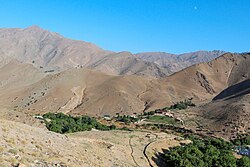
Back ولاية نواوي Arabic Provincia de Navoi AST Nəvai vilayəti Azerbaijani نوایی ویلایت AZB Наваіская вобласьць BE-X-OLD Навойска област Bulgarian নাভোই প্রদেশ Bengali/Bangla Província de Navoiy Catalan Навоийн область CE Navoiy Province CEB
Navoiy Region
Навоий вилояти / Navoiy viloyati (Uzbek) | |
|---|---|
Region | |
 | |
 Navoiy in Uzbekistan | |
| Coordinates: 42°0′N 64°15′E / 42.000°N 64.250°E | |
| Country | Uzbekistan |
| Capital | Navoiy |
| Government | |
| • Hokim | Normat Tursunov |
| Area | |
| • Total | 111,095 km2 (42,894 sq mi) |
| Elevation | 126 m (413 ft) |
| Population (2022) | |
| • Total | 1,033,857 |
| • Density | 9.3/km2 (24/sq mi) |
| Time zone | UTC+5 (East) |
| • Summer (DST) | UTC+5 (not observed) |
| ISO 3166 code | UZ-NW |
| Districts | 8 |
| Cities | 7 |
| Towns | 46 |
| Villages | 582 |
| Website | www |

Navoiy Region[a][b] is one of the regions of Uzbekistan. It is located in the central north/northwest of the country. It covers an area of 111,095 km2 (42,894 sq mi) (a large part of which is taken up by the Kyzyl-Kum desert), which makes it the largest of the regions of Uzbekistan (the autonomous Karakalpakstan Republic is still larger at 166,590 km2).[1] The Navoiy region borders with Kazakhstan, Samarqand Region, Buxoro Region, Jizzakh Region, and the Karakalpakstan Republic. The population is estimated to be 1,033,857 in 2022, with 51% living in rural areas.[2][3] The capital is Navoiy (pop. ~146,900).[4] The region and its capital are named after the poet Ali-Shir Nava'i.
The climate is a typically semi-desert continental climate. Navoiy region has significant natural resources, especially natural gas, petroleum, and precious metals, plus raw materials for construction. The region's economy is heavily dependent on large mining, metallurgical and chemical production complexes. The Navoi and Zarafshan mines produce some of the world's purest gold.
Leading agricultural products are cotton and Karakul sheep. Some 90% of the entire area is considered potentially rich agricultural land, if a source of water for irrigation can be located.
Cite error: There are <ref group=lower-alpha> tags or {{efn}} templates on this page, but the references will not show without a {{reflist|group=lower-alpha}} template or {{notelist}} template (see the help page).